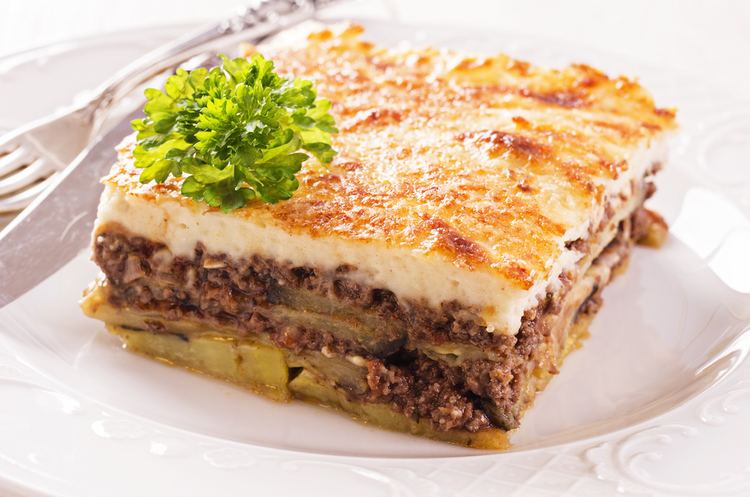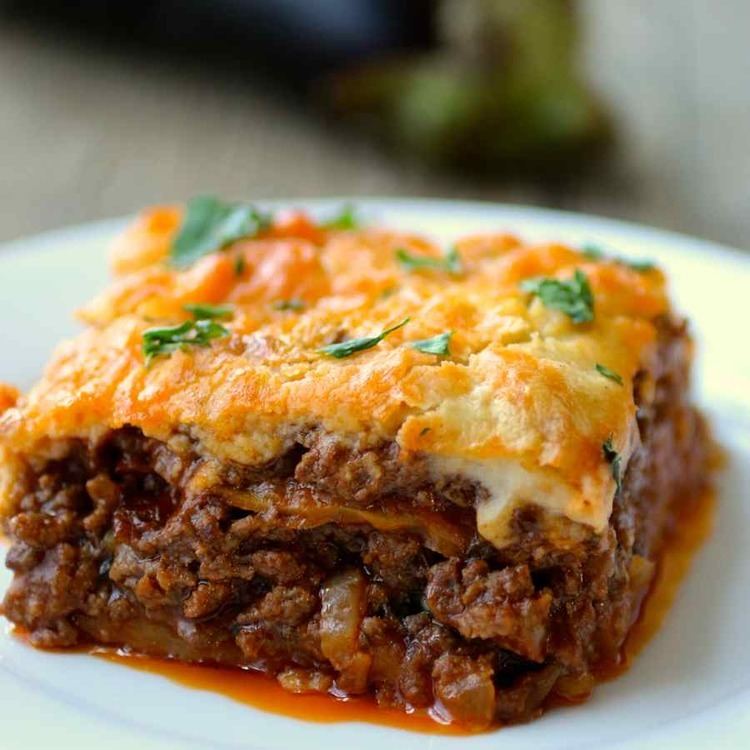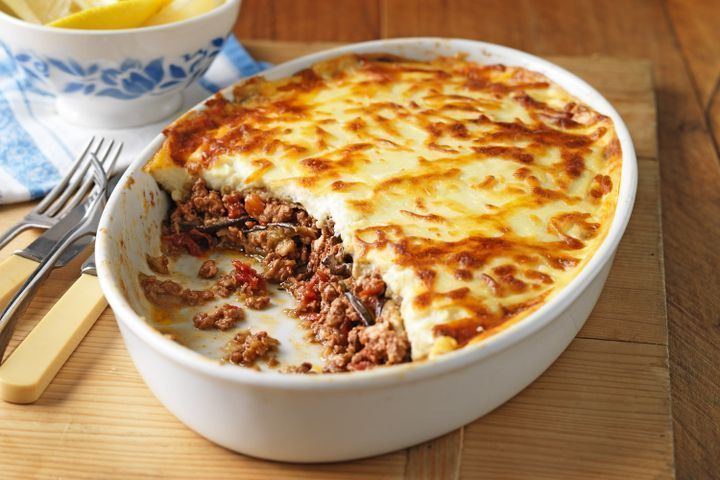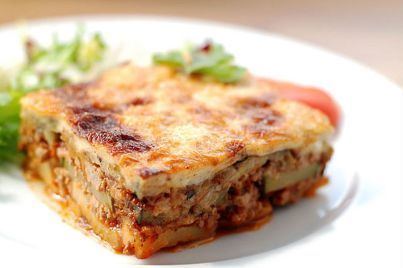Course Main course Variations Multiple | Serving temperature Hot | |
 | ||
Similar Souvlaki, Béchamel sauce, Pastitsio, Eggplant, Tzatziki | ||
How to make greek moussaka akis petretzikis
Moussaka (Arabic: مسقعة, /muːˈsɑːkə/, /ˌmuːsəˈkɑː/ or /ˌmuːsɑːˈkɑː/) is an eggplant- (aubergine) or potato-based dish, often including ground meat, in the Levant, Middle East, and Balkans, with many local and regional variations.
Contents
- How to make greek moussaka akis petretzikis
- Moussaka recipe
- Names and etymology
- Levant
- Egypt
- Greece
- Turkey
- Balkans
- References

In Greece, the dish is layered and typically served hot. In Turkey, it is sautéed and served in the style of a casserole, and consumed warm or at room temperature. In Arabic countries, a variant is eaten cold. Many versions have a top layer made of milk-based sauce thickened with egg (custard) or flour (béchamel sauce).

Moussaka recipe
Names and etymology

The English name for moussaka comes from Greek mousakás (μουσακάς), which derived from the Turkish musakka, which itself came from Arabic musaqqa‘ah (مسقعة), meaning "chilled".
Levant

In the Levant, moussaka is a cooked dish made up primarily of tomatoes and eggplant, similar to Italian caponata, and may also include chickpeas. It may be served cold as a mezze dish, or hot.
Egypt

The Egyptian version of moussaka is made from layers of fried eggplant immersed in tomato sauce and then baked. A layer of seasoned cooked ground beef is usually added between the eggplant before baking. The dish can be served hot but is usually chilled for a day or so to improve the taste.
Greece

Most versions are based primarily on sautéed aubergine (eggplant) and tomato, usually with minced meat, mostly lamb. However, the Greek version includes layers of meat and eggplant topped with a Béchamel ("white") sauce, and baked.
The modern Greek version was probably formulated by chef Tselementes in the 1920s. It has three layers that are separately cooked before being combined for the final baking: a bottom layer of sliced eggplant sautéed in olive oil; a middle layer of ground lamb lightly cooked with chopped or puréed tomatoes, onion, garlic, and spices (cinnamon, allspice and black pepper); and a top layer of Béchamel sauce or savoury custard. The composed dish is then layered into a pan and baked until the top layer is browned. Moussaka is usually served warm, not piping hot; if cut hot out of the oven, moussaka squares tend to slide apart and consequently the dish needs some resting time to firm up before serving. Reheating, however, does not present the same problem.
There are variations on this basic recipe, sometimes with no top sauce, sometimes with other vegetables. Such variants may include, in addition to the eggplant slices, sautéed zucchini (courgette) slices, part-fried potato slices, or sautéed mushrooms. There is a fast-day (vegan) version in the Greek cookbook by Tselementes, which includes neither meat nor dairy products, just vegetables (ground eggplant is used instead of ground meat), tomato sauce, and bread crumbs.
Another variant is (melitzanes) papoutsakia (μελιτζάνες) παπουτσάκια (lit. 'eggplant, little shoe style') which consists of whole small eggplant stuffed with ground meat and topped with béchamel and baked, somewhat similar to the Turkish karnıyarık.
Turkey
Turkish musakka is not layered. Instead, it is prepared with sautéed eggplant, green peppers, tomatoes, onions, and minced meat. It is generally eaten with pilav and cacık. There are also variants with zucchini (kabak musakka), carrots (havuç musakka) and potatoes (patates musakka).
Balkans
Albanian, Bulgarian, Bosnian, Croatian, Macedonian, Montenegrin, Romanian, Slovenian and Serbian versions use potatoes instead of eggplant, pork or beef mince, and the top layer is usually milk or yogurt mixed with raw eggs, sometimes with a couple of spoons of flour added. There is also a three-layer version: the bottom layer consists of ground pork and beef, the middle layer of potato slices, and the top layer is typically a custard. Each layer is cooked on its own and layered in a pan and baked until the top is browned.
The Romanian version is made usually with potatoes or eggplant or cabbage. The layers start with the vegetable, then the layer of meat (usually pork), then vegetables, until the pot is full. Sometimes bread crumbs are used for toppings, sometimes slices of tomatoes and crushed cheese. The pot is then filled with tomato sauce. There is also a pasta variant, with pasta being used instead of vegetables. The "fasting" variant, which is vegan, replaces meat with mushrooms or a mix of sautéed onions and rice.
In the rest of the Balkans, the top layer is often a custard: this is the version introduced in the UK by Elizabeth David's Mediterranean Cookery and where it remains the usual presentation. Grated cheese or bread crumbs are often sprinkled on top.
